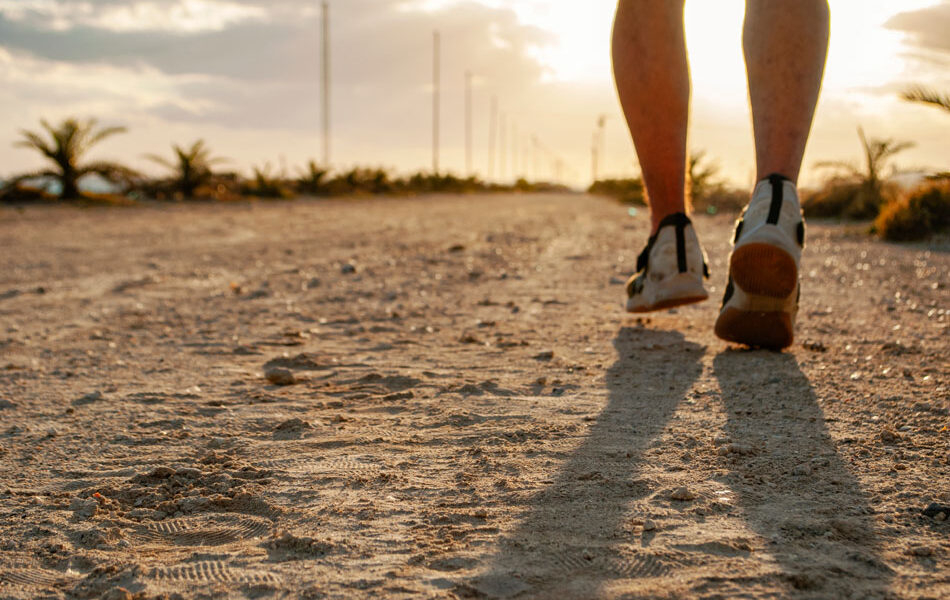Brisk Walking: Benefits, Pace and Heart Rate
Speeding up your walking pace by even half a mile per hour can have a surprising impact on the number of health benefits you can gain from your daily stroll.

When you think of the best exercises to boost your cardiovascular endurance and burn calories, walking probably isn’t at the top of the list.
But you’d be surprised by how many of the same health benefits daily 30-minute strolls can offer compared to more high-intensity activities like running.
If you’re thinking about getting into the habit of brisk walking, this article can tell you everything you need to know about how to brisk walk and the benefits of doing so.
What Is Brisk Walking?
Brisk walking is a moderate-intensity physical activity that falls somewhere between walking at a leisurely pace and jogging.
People brisk walk as a way to maximize the health benefits they can experience from walking while limiting the possibilities for injury compared to running or jogging.
What Is a Normal Brisk Walking Pace?
How quickly you can brisk walk will depend on things like your current level of fitness, muscle strength, cardiovascular endurance, and whether or not you are suffering from any physical activity-related injuries.
Generally speaking, it’s not considered brisk walking unless you walk at a pace of 3 miles per hour or more.
Walking faster, somewhere between the range of 5–7 miles per hour, is technically considered speed walking, so the ideal speed for anyone wanting to brisk walk is to aim for 3–5 miles per hour.
The biggest difference between the two is that you want to keep your heart rate between 50–85% of the maximum when brisk walking.
When brisk walking, you want to make sure you stay at a conversational pace, meaning you have enough air in your lungs to carry on a conversation, but not so much that you can walk and sing a song.
Brisk Walking Heart Rate
The recommendation for you to step up your walking pace comes largely from the effect that an increase in walking speed can have on the heart rate.
As your heart rate increases, so does your blood flow. This increase in blood flow, as well as an added level of pressure as it moves through the arteries, is what keeps your cardiovascular system strong and healthy.
The resting heart rate of a physically fit person will generally be around 50% of their MHR.
Since brisk walking is considered a moderate-intensity exercise, it is recommended to elevate your heart rate to 64–76% of your maximum heart rate, according to the CDC.
How to calculate your maximum heart rate (MHR)?
An estimate of your maximum heart rate can be calculated by simply subtracting your age from the number 220.
220 – 35 = 185
So, if you’re 35 years old, your maximum heart rate will be approximately 185 beats per minute (BPM).
From there, the process of calculating your heart rate range can be calculated by multiplying your MHR by 0.64 (64%) and 0.76 (76%) since you are aiming to be between 64–76% of your MRH while brisk walking.
185 x 0.64 = 118 and 185 x 0.76 = 140
Therefore, a 35-year-old brisk walker would want to adjust their pace so that their heart rate is somewhere between 118 and 140 BPM.
There are a few different options to track your heart rate, but the easiest by far is picking up a heart rate monitor. You can find inexpensive chest-strap heart rate monitors for as little as $50 and monitors for your wrist for around $80.
Here is a chart with pre-calculated target heart rate ranges based on age:
| Age (years) | Target heart rate (BPM)Low end (64%) | Target heart rate (BPM)High end (76%) |
| 20 | 128 BPM | 152 BPM |
| 30 | 121 BPM | 144 BPM |
| 40 | 115 BPM | 137 BPM |
| 50 | 109 BPM | 129 BPM |
| 60 | 102 BPM | 122 BPM |
| 70 | 96 BPM | 114 BPM |
5 Benefits of Brisk Walking
Walking of any kind can provide ample benefits, but walking at a faster pace, even an extra half mile per hour, can help you turn a daily stroll into an exercise program that will help you lose weight, build strength, and even contribute to lower blood pressure.
Below, you’ll find just a few benefits that you can glean from a consistent brisk walking routine.
#1 Burns more calories
Increasing your walking pace can significantly increase the number of calories you burn as you walk.
This is because as you walk faster, you force more of your major muscle groups to exert more effort to keep you moving. All muscles use energy in the form of calories to fuel your movements, which helps you burn more calories as you move.
According to a Harvard study, a 155-pound person walking at a pace of 3.5 miles per hour can burn on average about 133 calories in a 30-minute period, while the same person walking at 4 miles per hour – which is only a half a mile increase – will burn up to 175 calories.
Instead of aiming to walk 20,000 steps a day, you can focus on increasing your walking speed even slightly to maximize its calorie-burning potential.
#2 Improves cardiovascular health
The biggest difference between running vs. walking is the number of calories you can expect to burn by doing each exercise, but when it comes to improving heart health, both exercises are more or less equally effective.
According to this study, both running and walking produce more or less the same effects when it comes to lowering cholesterol and high blood pressure and can even play a part in reversing the effects of diabetes.
Participants in this study were instructed to bump up their walking pace and likely wouldn’t have seen the same effects had they walked at a more leisurely pace.
Bumping up the intensity of your leisurely stroll is what will help you prevent heart disease and improve the health of your cardiovascular system as a whole.
#3 Lessens the impact on bones and joints
The level of impact that your bones and joints experience while brisk walking and running is another major difference between these popular exercise styles.
High-impact activities, like running, can have a deteriorating effect on your bones, especially the bones in your feet and shins. They can also put unnecessary strain on the joints in your lower body and cause serious injury to the knees.
Brisk walking is an exercise option that provides many of the same benefits as running but with a fraction of the impact.
When you run, both of your feet leave the ground simultaneously and create a jarring impact when you hit the ground. On the other hand, when you walk briskly, one of your feet always remains on the ground.
This makes it an ideal exercise for injury-prone, overweight, or older people since it can strengthen the body while reducing their risk of injury.
#4 Builds muscle strength
You might be asking yourself, can brisk walking even build muscle? And the answer is yes.
Although you can’t expect to walk your way to big, bulky muscles, getting in the habit of regular brisk walking will improve your muscle strength in your lower body and leave you looking more toned.
Fast-twitch muscle fibers are what our bodies create in response to high-intensity activity. These muscle fibers are great for carrying out short bursts of intense movement and are slightly larger than the other style of muscle fiber, which is slow twitch.
Slow twitch muscle fibers are made during low to moderate-intensity exercise such as brisk walking and keep the muscles strong and oxygenated during longer periods of exercise.
#5 Improves mental health
Any form of exercise, especially when made into a daily routine, can have enormous effects on your mental health, and the same can be said about brisk walking.
As you walk, your body releases endorphins, which are our body’s natural pain relievers. They create a positive feeling when released into the body, and this feeling is what people often refer to as a runner’s high.
This release of endorphins combined with time spent outdoors can significantly reduce stress levels and improve cognitive function. These effects will only continue to compound when you get into the habit of regular brisk walks.
How to Properly Brisk Walk?
Although brisk walking is generally safe, you will be vulnerable to a few types of injuries, including muscle strains or tears and shin splints. You can reduce your risk level by ensuring you do a proper warm-up before exercising and cool down afterward.
Warm up and cool down
Before increasing your walking speed up to the 3–5mi per hour range, it’s a good idea to start your walk at a more leisurely pace. Doing so will help get your muscles and joints warm and can help prevent things like muscle strains or a sprained ankle.
Even 5 minutes of walking below your target brisk walking pace will be enough to make a difference. But if you have the time, doing a more thorough warm-up like the one below is recommended before starting your walk.
Doing a post-workout stretch is a helpful way to promote balance between your muscles and prevent unnecessary tightness that could restrict your range of motion later on.
Taking 5 or 10 minutes to do a stretch for the quadriceps, a stretch for the hamstrings, a stretch for your calf muscles, and something to help keep your hips loose should be more than enough.
On the days when you have extra time or feel more stiff than usual, try a longer post-workout and cool-down stretch like the one below.
If you want to learn more about brisk walking and other walking techniques we would recommend trying Walking.diet.

- Offers walking training plan
- Provides warm-up and cool-down workouts before and after walking workout
- Includes keto desserts cookbook
- Offers the articles about food and nutrition, walking gear
FAQs
Your target heart rate while walking will differ depending on your age and sex. On average, both men and women should expect to be in the range of 60–100 BPM regardless of their age.
According to this study, the perfect walking time is 30 minutes.
Going for a 30-minute walk 5 times a week is clinically proven to significantly decrease body weight and improve cardiovascular fitness.
Generally, you should aim to walk 3–3.5 miles per hour. Another way that you can calculate your walking pace is to count your steps and walk at least 100 steps a minute.
If you are physically unfit, you could also use your heart rate to indicate how fast you should be walking instead of aiming for a certain pace. Ideally, while brisk walking, you would be between 64–76% of your MHR.
A Word From Our Coach
Getting into the habit of regular exercise is always more accessible when you do it with friends.
This level of accountability can be the difference between you showing up for your walks instead of watching TV at home, especially on days when you’re feeling unmotivated.
If you don’t have any friends interested in going for walks with you, you might consider joining a walking group. Doing so will give you the opportunity to make new friends while soaking up all the benefits of brisk walking together.
Bottom Line
Walking at a brisk pace is an easy way to maximize the health benefits of going for a daily stroll. They involve walking 3–5 miles per hour, between 64–76% of your MHR.
Brisk walking is an ideal form of exercise for anyone who is currently overweight, as well as older adults. Since it is so low-impact, it is a great stepping stone for easing anyone who is physically unfit back into more vigorous aerobic activity.
Through regular brisk walking, you can expect to begin losing weight, lowering your blood pressure, increasing your muscle strength, and overall contributing to a healthier, happier life.

















































 Select your language:
Select your language: 








